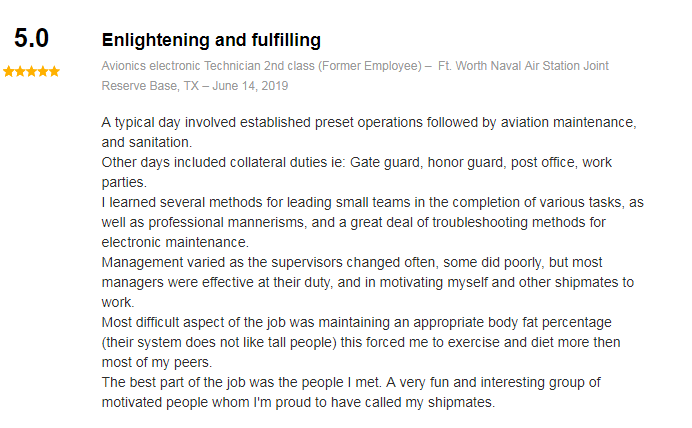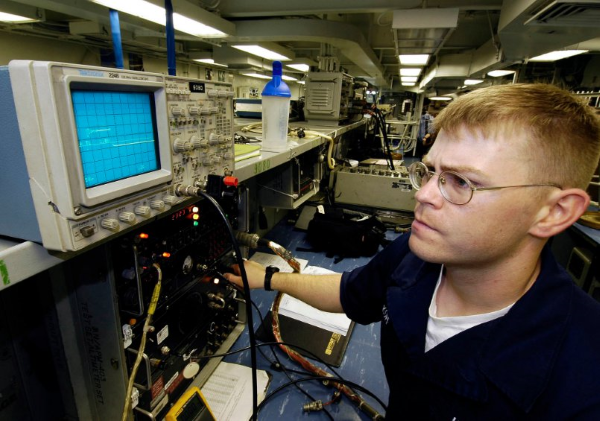If you like working with your hands and have a high electrical and mechanical aptitude, then you will want to strongly consider entering the Navy as an Aviation Electronics Technician.
This is a demanding and important job that can enable you to see the world and pave a pathway to a well-paying civilian job.
Once you become a Navy Aviation Electronics Technician, you will join an elite group of Navy enlisted personnel that help to keep the electronic systems and subsystems on the world’s most advanced aircraft in good working order.
Related Article – Navy Master At Arms (MA): Career Details
Some of the demands that are placed on those who call themselves Navy Aviation Electronics Technicians include:
- Maintain, repair, and calibrate a huge range of cutting-edge electronic equipment
- Repair and maintain equipment involved in communications, threat detection, navigation, electronic countermeasures, and tracking & identification systems
- Work with nuclear-based electronic technologies such as nuclear reactor control, propulsion systems, and power generation on Navy nuclear-powered vessels
- May volunteer to become an AT on a flight crew
Wherever the Navy goes on air, sea, and land, a well-trained Aviation Electronics Technician will need to go with them to ensure the Navy’s many advanced electronic systems are kept working properly.
More on what a Navy Aviation Electronics technician does can be seen in the YouTube video below:
Jump To A Section
Navy Aviation Electronics Technician Requirements and Qualifications
Here is what it takes to qualify to start training to become an enlisted US Navy Aviation Electronics Technician:
Educational Requirements
To join the U.S. Navy, you’ll need a high school diploma or GED equivalent.
ASVAB Requirements
To become an AT, you’ll need a minimum combined ASVAB Score of 217 on Verbal Expression (VE), Mechanical Comprehension (MC), Arithmetic Reasoning (AR), and Math Knowledge (MK).
Alternatively, you’ll also qualify with a minimum combined ASVAB Score of 217 on VE+AR+MK+Assembling Objects (AO).
Additional Qualifications
- Be between the ages of 17 and 41 unless in possession of a waiver
- Be a United States citizen and eligible for a security clearance.
- Must have at least average physical strength and have good manual dexterity
- Your vision must be correctible to 20/20, and you must have a full field of vision, normal depth perception, and normal color perception.
- An electrical or mechanical background is preferred but not required.
- Proficiency with computer use is also desired.
You’ll need to successfully complete 10 weeks of Navy Basic Recruit Training held at Great Lakes Naval Training Center, which is located on the western shore of Lake Michigan, close to Chicago. (This may not be required of those with prior military experience or training)
You’ll also have to complete a current Single Scope Background Investigation (SSBI) that will allow that enlisted person to obtain a Secret or higher level security clearance
*** Note: For someone who wants to be a nuclear-related Aviation Electronics Technician (ATN), those jobs entail ASVAB scores and qualifications that will be even higher than this. ***
Related Article: US Navy Age Limits
Training and Career Path to Become a Navy Aviation Electronics Technician
Once a recruit completes the requirements and qualifications stated above, they will then proceed on the following technical training path.
Navy Technical Training Information
Technical training starts with the AT Basic Technical Training School held at Great Lakes Naval Training Center in Illinois.
This course in the fundamentals of electronics maintenance and troubleshooting lasts approximately 9 weeks.
After that, the trainee will proceed to the Class “A” Technical Training School at the Navy Technical Training Center (NATTC) located in Pensacola, Florida.
Here the Seaman recruit will spend 19 weeks learning how to function as a seasoned Navy Aviation Electronics Technician.
This part of the technical training involves learning about such things as radar and advanced communications installation and repair.
On the Job Training

Every new Navy Aviation Electronics Technician undergoes a short on-the-job training session once they arrive at their first duty assignment.
This on-the-job training period will further hone the new recruit’s skills to those that are related to their current electronics working environment.
How Much Are US Navy Aviation Electronics Technicians Paid?
US Navy Aviation Electronics Technician pay is based on the same enlisted pay scale as any other Navy job.
The two characteristics that determine a Navy enlisted member’s base pay are their current rank and the amount of time they have spent in the military.
Most new US Navy Airman will start out at the pay grade of Seaman Recruit (E-1). Some may have special skills or schooling that will allow them to start out as a Seaman Apprentice (E-2) or Seaman (E-3).
Here is the current pay table for Navy enlisted members based on rank and time in service:
Advancement through the Seamen ranks (E-1 to E-3) is done automatically based on time in grade.
Higher enlisted non-commissioned officer pay grades (E-4 and above) are achieved by a combination of test scores, job proficiency, and the amount of time spent in a current pay grade.
Miscellaneous Pay, Allowances, and Incentives
There are other forms of payment that may add to someone’s paycheck while they are serving their country in the Navy too.
These include:
- Housing allowance for those authorized to live off base (BAH)
- Subsistence allowance (Food – BAS)
- Temporary duty pay
- Hazardous duty pay
- Sea duty pay (Separation pay)
- 100% paid healthcare
- Tuition reimbursement
Related Article: Navy Enlisted And Officer Ranks And Pay
What’s Life Like as a Navy Aviation Electronics Technician?
This is a demanding and challenging Navy career field, to say the least, but it also comes with many rewards too.
Those who become Navy Aviation Electronics Technicians will feel the pressure of working in an intense, fast-paced environment where there is little room for error.
A workday will never be boring, and there is ample downtime to pursue one’s own hobbies and interests too.
There is also a vast opportunity to travel the globe and see the world and make lifelong friends while being a Navy Aviation Electronics Technician.
Unless in wartime or under other unusual alert statuses, enlisted Navy Aviation Electronics Technicians enjoy weekly days off, rotating shore leave when in port, and 30 days yearly paid leave (vacation) each year.
Aviation Electronics Technician Job Reviews
Here is what a few former Navy enlisted members had to say on the website Indeed.com about their experiences as a Navy Aviation Electronics Technician:


US Navy Aviation Electronics Technician Civilian Career Opportunities
This is a navy job that will lay a great foundation for future civilian employment.
In today’s modern world, electrical and electronic troubleshooting-related jobs are in very high demand and usually come with very good salaries too.
Ex-Navy Aviation Electronics Technicians should have little or no problem quickly finding rewarding civilian employment.
Related Article – Navy Aircrewman Career Details
Examples of positions that Navy Aviation Electronics Technicians typically fill are:
- Working as private contractors for the Army, Navy, Marines, Air Force, Coast Guard, Air Force Reserve, and US Government.
- Maintaining ground and tower control radar systems at airports
- Gaining employment with utility and communications companies
- Troubleshooting equipment for transportation and logistics companies
- Working in service departments for electrical goods and computer manufacturers
- Power grid service technicians
- Helping both domestic and cargo airlines maintain their avionics systems
Here are some examples of civilian companies that hire Ex-Navy Aviation Electronics Technicians:
- Lockheed Martin Corporation – Greenville, SC
- Sierra Nevada – Colorado Springs, CO
- PEMCO/Airborne – Tampa, FL
- Signature Flight Support – Frederick, MD
- Constant Aviation – Mesa, AZ
- Teledyne Controls – El Segundo, CA
- VSE Aviation – Miramar, FL
Note that the security clearance that any Ex-Navy Aviation Electronics Technician possesses may prove a valuable commodity when job hunting.
References:
- 5 Worst Jobs in the Air Force - June 20, 2024
- 4 Steps For Visiting An Air Force Recruiter Near You - June 19, 2024
- Air Force Safety Specialist (1S0X1) - June 19, 2024




